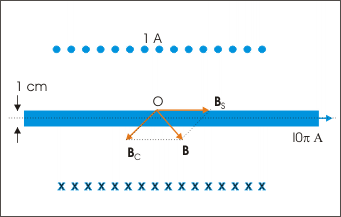| << Chapter < Page | Chapter >> Page > |
Solution : The magnetic field due to solenoid is uniform inside the solenoid and is given as :
The magnetic field due to straight conductor on its surface is :
Magnetic field due solenoid and straight conductor

The magnetic field due to straight conductor is tangential to the circumference and hence is perpendicular to magnetic field due to solenoid. The resultant magnetic field is, therefore,
Both solenoid and straight conductor produces equal magnetic field at the surface of conductor. It is interesting to observe that a straight conductor requires a current of magnitude which is 10π i.e. 31.4 times the current in solenoid. This illustrates the effectiveness of solenoid over a straight conductor in setting up a magnetic field with respect to straight conductor. For this reason, a solenoid is generally used as a magnet in application situations.
Problem 10: A long cylindrical conductor of radii “a” is coaxially placed inside an annular cylindrical conductor of radii “b” and “c”. The perpendicular cross section of the coaxial annular cylinders is shown in the figure below. If currents in two conductors are I each but in opposite direction, then find magnetic field at a point (i) inside the inner conductor (ii) region between two cylinders (iii) inside annular cylinder and (iv) outside the annular cylinder. Assume current density to be uniform in both cylinders.
Magnetic field due to current in coaxial cylindrical conductors

Solution : We note that current densities in two cylinders are uniform. To find magnetic field at a point inside the inner cylinder, we first determine its current density.
Note that current outside the Ampere loop in the inner cylinder and current in the outer conductor do not contribute towards enclosed current. Applying Ampere’s law for a loop of radius r inside the inner cylinder,
To find magnetic field at a point between inner and outer cylinders, we apply Ampere’s law for a loop of radius r between the region (a<r<b). Note that outer conductor does not contribute towards enclosed current. Applying Ampere’s law for a loop of radius r between inner and outer cylinders,
To find magnetic field at a point inside the outer cylinder, we apply Ampere’s law for a loop of radius r between the region (b<r<c). Note that current in the inner conductor and annular region defined by b<r<c contribute towards enclosed current. In order to find the enclosed current in the outer cylinder, we first determine its current density.
Further the current in inner and outer cylinders are opposite in direction. We observe here that current density of inner cylinder is greater as current I is divided by smaller area. Thus, we shall deduct the current through the annular region of outer cylinder from the current in inner cylinder. Applying Ampere’s law for a loop of radius r inside the outer cylinder,
To find magnetic field at a point outside the outer cylinder, we apply Ampere’s law for a loop of radius r (r>c). The net current the loop is zero. Hence,

Notification Switch
Would you like to follow the 'Electricity and magnetism' conversation and receive update notifications?